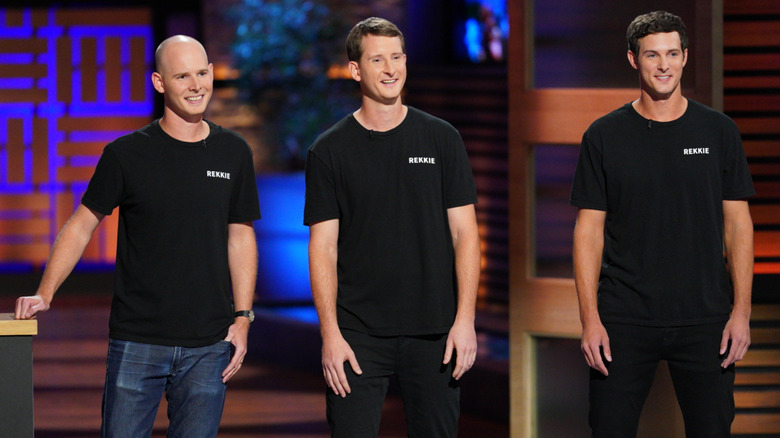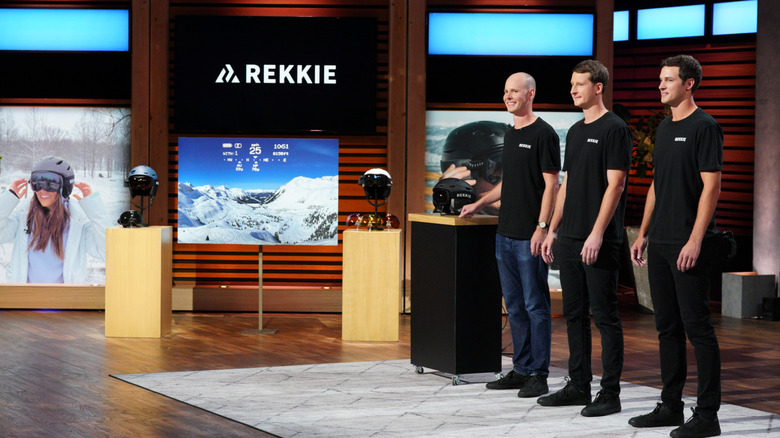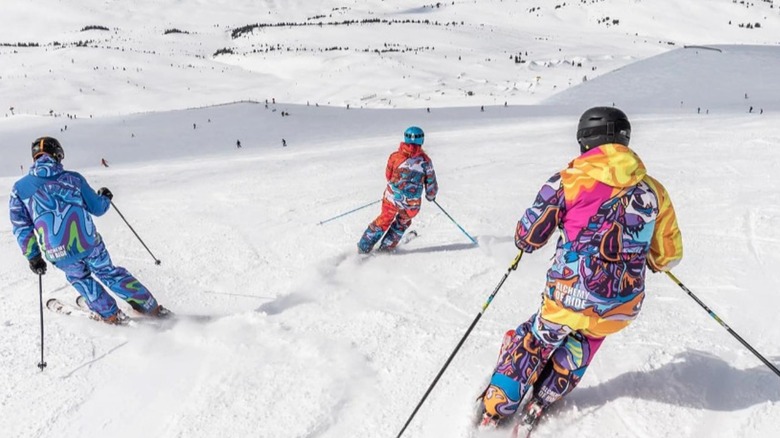Rekkie: 3 Things You Didn't Know About The Shark Tank Product
The most successful "Shark Tank" products are often those that innovate in their respective fields, and Rekkie is no exception. Featured in Season 15, Episode 7, the Rekkie product line offers high-tech smart snow goggles for skiers, snowboarders, and hikers. Through the use of AR functionality, these headsets allow users to see all sorts of information on their heads-up display as they're hitting the slopes, including their current speed, altitude, and cardinal direction. Put more simply, it's a bit like having the display from Iron Man's suit without the superpowered armor to go with it.
Rekkie both looks and sounds pretty cool on its face, but there are a couple more interesting facts that "Shark Tank" fans might like to learn about the gadget, including how the idea for it came about, how it works, and the surprisingly sizable suite of features it offers. Here's what readers should know about Rekkie.
Rekkie was born from a frustrating experience
Similar to Tik Pik and many other "Shark Tank" gadgets, Rekkie's origin stems from its creators personally encountering a problem and then endeavoring to solve it. In this case, it was Rekkie co-founder Henry Pease who found himself in an unfortunate situation while traversing a snowy mountain with friends. As the story is told on the official Rekkie site, Pease was separated from his group without an easy way to get in contact with them. While he was able to eventually reunite with his group, it got him thinking about a way to provide skiers, snowboarders, and mountaineers a way to easily stay connected while braving the elements.
Eventually, Pease and his co-founders came up with the concept of Rekkie, which not only features a bunch of useful information on external conditions but also prioritizes tracking group members on the slopes right down to their exact distance from the wearer at any given point. Incidentally, the name Rekkie is actually a reference to a British slang term for the word "reconnaissance," reiterating that the central purpose of the product is all about helping one understand their surroundings.
Rekkie's smart features go beyond ski navigation
If having positional tracking and a bunch of other navigation information wasn't enough, Rekkie is stuffed with even more features for users, including a few surprising options. Seeing as the AR headset must pair with a user's phone via Bluetooth to achieve full functionality, it seems the creators went full steam ahead with allowing wearers to make use of their phone's features through the goggles.
Through the use of a singular button and head motion tracking technology within the headset, Rekkie users can navigate several menus and extra options. One nifty feature allows the wearer to control music on a connected speaker, such as a pair of wireless earbuds. The headset can also display incoming text messages and calls, the latter of which can similarly be answered with a connected speaker.
In essence, Rekkie is dedicated to providing a (mostly) hands-free method to use basic phone functionality, so that users don't have to worry about checking their device in the midst of a snowy mountain outing.
Rekkie works with a robust app
Rekkie may have an impressive list of features and an overall solid execution, but there's no denying that its status as a premium piece of tech makes it a bit of a niche product. At a retail price of $349 for the goggles, it's not quite in the range of impulse buy territory, and even some of those interested in the product might be reluctant to take the plunge. Fortunately, the official Rekkie app allows consumers to make some use of the headset's functionality, even if they don't own one themselves.
In order to fully use the Rekkie headset, users must pair it with their phone through a free downloadable app. However, that's not the only reason people might download the app. Even those who don't own a pair of the smart goggles themselves can still operate the app to join a group with other users, allowing them to view their friends' locations if they're using a Rekkie headset. Essentially, even just one Rekkie headset amongst a group can help people stay in contact with one another.
What happened to Rekkie on Shark Tank?
During their appearance on "Shark Tank," the Pease brothers find themselves in the trenches like the countless entrepreneurs before them. They are looking for a hefty $300,000 investment in exchange for 10% equity. Multiple offers fly their way, with Kevin O'Leary and Mark Cuban being the main Sharks interested in Rekkie. While Barbara Corcoran does show initial interest, she backs out after hearing the goggles don't have certain map and trail functions.
In classic Mr. Wonderful fashion, O'Leary's proposal is the most aggressive, with the Canadian businessman willing to give the Pease brothers $300 thousand for 20% equity, so long as he also receives twenty cents on every single dollar the company earns. O'Leary isn't able to press the issue much once Cuban steps up to the plate.
Mark Cuban's initial offer is $300 thousand for only 15% equity. However, the Rekkie founders don't immediately bite at the offer. They counter Cuban, asking him to drop to 12.5% equity; their desire to bring their business to law enforcement and military sectors seems to appeal to the Dallas Mavericks owner, and Cuban agrees. The Rekkie founders quickly shake hands with Cuban and leave "Shark Tank" with a deal.




